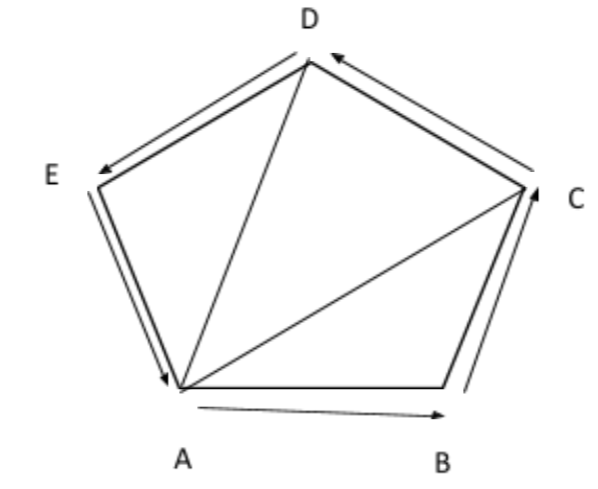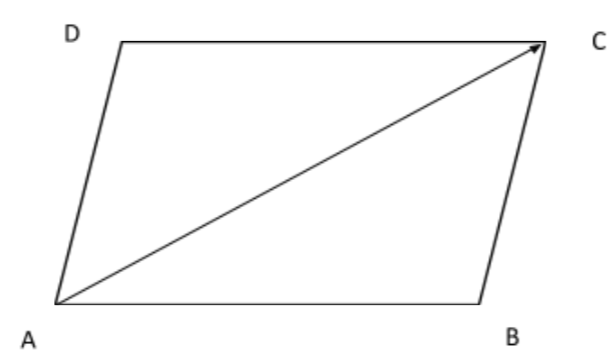
$\begin{align}
& If\text{ }ABCDE\text{ is a pentagon, then }\overrightarrow{AB}\text{ + }\overrightarrow{AE}\text{ +}\overrightarrow{\text{ }BC}\text{ +}\overrightarrow{\text{ }DC}\text{ + }\overrightarrow{ED}\text{ + }\overrightarrow{AC}\text{ equals} \\
& \text{A}\text{. 3}\overrightarrow{\text{AD}} \\
& \text{B}\text{. 3}\overrightarrow{AC} \\
& \text{C}\text{. 3}\overrightarrow{BE} \\
& \text{D}\text{. 3}\overrightarrow{CE} \\
\end{align}$
Answer
573.6k+ views
Hint: In the given question we have to find out sum of some vector. So, we have to know that how we can do the addition of vector and we should know the meaning of vector. A vector is a quantity which has both, that is magnitude as well as direction and which obey triangle rule of addition. Triangle rule of addition says that in a triangle if we add the sides of triangle in cyclic order the sum is zero. So, if ABC is a triangle then according to the triangle rule of addition, we can write $\overrightarrow{AB}\text{ }+\text{ }\overrightarrow{BC}\text{ }+\text{ }\overrightarrow{CA}\text{ }=\overrightarrow{\text{ }0}$. Also $\overrightarrow{AB}\text{ }=\text{ }-\overrightarrow{BA}$. In the given we have to add $\overrightarrow{AB}\text{ }+\overrightarrow{\text{ }AE}\text{ }+\text{ }\overrightarrow{BC}\text{ }+\text{ }\overrightarrow{DC}\text{ }+\text{ }\overrightarrow{ED}\text{ }+\text{ }\overrightarrow{AC}$so here we add two vector as $\overrightarrow{AB}\text{ }+\text{ }\overrightarrow{BC}$and $\overrightarrow{AE}\text{ }+\text{ }\overrightarrow{ED}$ so that we get third side of corresponding triangle and them move further.
Complete step-by-step solution:
Let ABCDE is a pentagon and we have to find $\overrightarrow{AB}\text{ }+\text{ }\overrightarrow{AE}\text{ }+\text{ }\overrightarrow{BC}\text{ }+\overrightarrow{\text{ }DC}\text{ }+\text{ }\overrightarrow{ED}\text{ }+\text{ }\overrightarrow{AC}$

Consider the triangle ABC, we can write
$\overrightarrow{AB}\text{ }+\text{ }\overrightarrow{BC}\text{ }+\text{ }\overrightarrow{CA}=0$
Here we use triangle law of addition, so we can write
$\begin{align}
& \overrightarrow{AB}\text{ }+\text{ }\overrightarrow{BC}=\text{ }-\overrightarrow{CA} \\
& \overrightarrow{AB}\text{ }+\text{ }\overrightarrow{BC}\text{ }=\text{ }\overrightarrow{AC}------(a) \\
\end{align}$
Now in triangle AED we again use triangle law of addition so, we can write
\[\begin{align}
& \overrightarrow{AE}\text{ }+\text{ }\overrightarrow{ED}\text{ }+\text{ }\overrightarrow{DA}\text{ }=\text{ }\overrightarrow{0} \\
& \overrightarrow{AE\text{ }}+\text{ }\overrightarrow{ED}=-\overrightarrow{DA} \\
& \overrightarrow{AE}\text{ }+\text{ }\overrightarrow{ED}=\text{ }\overrightarrow{AD}-----(b) \\
\end{align}\]
Again, we consider triangle ACD and we use here again triangle rule of addition, so, we can write
\[\begin{align}
& \overrightarrow{AC}\text{ }+\text{ }\overrightarrow{CD}\text{ }+\text{ }\overrightarrow{DA}=\text{ }0 \\
& \overrightarrow{AC}\text{ }+\text{ }\overrightarrow{CD}\text{ }=\text{ }-\overrightarrow{DA} \\
& \overrightarrow{AC}\text{ }+\text{ }\overrightarrow{CD}\text{ }=\text{ }\overrightarrow{AD}------(c) \\
\end{align}\]
Now we do here$(a)+(b)+(c)$, so we can write
\[\overrightarrow{AB}\text{ }+\text{ }\overrightarrow{BC}\text{ }+\text{ }\overrightarrow{AE}\text{ }+\text{ }\overrightarrow{ED}\text{ }+\text{ }\overrightarrow{AC}\text{ }+\text{ }\overrightarrow{CD}\text{ }=\overrightarrow{AC}\text{ }+\text{ }\overrightarrow{AD}\text{ }+\text{ }\overrightarrow{AD}\]
Now we add $\overrightarrow{DC}$both side we can write
$\overrightarrow{AB}\text{ }+\text{ }\overrightarrow{BC}\text{ }+\text{ }\overrightarrow{AE}\text{ }+\text{ }\overrightarrow{ED}\text{ }+\text{ }\overrightarrow{AC}\text{ }+\text{ }\overrightarrow{CD}\text{ }+\text{ }\overrightarrow{DC}\text{ }=\text{ }\overrightarrow{AC}\text{ }+\text{ }\overrightarrow{AD}\text{ }+\text{ }\overrightarrow{AD}\text{ }+\text{ }\overrightarrow{DC}$
Taking $\overrightarrow{CD}$to right hand side we can write
\[\begin{align}
& \overrightarrow{AB}\text{ }+\text{ }\overrightarrow{BC}\text{ }+\text{ }\overrightarrow{AE}\text{ }+\text{ }\overrightarrow{ED}\text{ }+\text{ }\overrightarrow{AC}\text{ }+\overrightarrow{\text{ }DC}\text{ }=\text{ }\overrightarrow{AC}\text{ }+\text{ }\overrightarrow{AD}\text{ }+\text{ }\overrightarrow{AD}\text{ }+\text{ }\overrightarrow{DC}\text{ }-\text{ }\overrightarrow{CD} \\
& \overrightarrow{AB}\text{ }+\text{ }\overrightarrow{BC}\text{ }+\text{ }\overrightarrow{AE}\text{ }+\text{ }\overrightarrow{ED}\text{ }+\text{ }\overrightarrow{AC}\text{ }+\text{ }\overrightarrow{DC}\text{ }=\text{ }\overrightarrow{AC}\text{ }+\text{ }\overrightarrow{AD}\text{ }+\text{ }\overrightarrow{AD}\text{ }+\text{ }\overrightarrow{DC}\text{ }+\text{ }\overrightarrow{DC} \\
& \overrightarrow{AB}\text{ }+\text{ }\overrightarrow{BC}\text{ }+\text{ }\overrightarrow{AE}\text{ }+\text{ }\overrightarrow{ED}\text{ }+\text{ }\overrightarrow{AC}\text{ }+\text{ }\overrightarrow{DC}\text{ }=\text{ }\overrightarrow{AC}\text{ }+\text{ }2(\overrightarrow{AD}\text{ }+\text{ }\overrightarrow{DC}) \\
\end{align}\]
Now in triangle ADC we have
$\begin{align}
& \overrightarrow{AD}\text{ }+\text{ }\overrightarrow{DC}\text{ }+\text{ }\overrightarrow{CA}\text{ }=\text{ }\overrightarrow{0} \\
& \overrightarrow{AD}\text{ }+\text{ }\overrightarrow{DC}\text{ }=\text{ }-\overrightarrow{CA} \\
& \overrightarrow{AD}\text{ }+\text{ }\overrightarrow{DC}\text{ }=\text{ }\overrightarrow{AC}-----(d) \\
\end{align}$
Now we can substitute the value of $\overrightarrow{AD}\text{ }+\text{ }\overrightarrow{DC}$ from equation $(d)$ we can write
$\begin{align}
& \overrightarrow{AB}\text{ }+\text{ }\overrightarrow{BC}\text{ }+\text{ }\overrightarrow{AE}\text{ }+\text{ }\overrightarrow{ED}\text{ }+\text{ }\overrightarrow{AC}\text{ }+\text{ }\overrightarrow{DC}\text{ }=\text{ }\overrightarrow{AC}\text{ }+\text{ }2(\overrightarrow{AC}) \\
& \overrightarrow{AB}\text{ }+\text{ }\overrightarrow{BC}\text{ }+\text{ }\overrightarrow{AE}\text{ }+\text{ }\overrightarrow{ED}\text{ }+\text{ }\overrightarrow{AC}\text{ }+\text{ }\overrightarrow{DC}\text{ }=\text{ }3\overrightarrow{AC} \\
\end{align}$
Hence, option B is correct.
Note: The addition of vector can be done by the rule of parallelogram also. According to it if $\overrightarrow{a}$ and $\overrightarrow{b}$ are two vectors which is to be added we form a parallelogram by using $\overrightarrow{a}$ and $\overrightarrow{b}$ as the side of parallelogram. One of the diagonals (main) so formed is the addition of vectors.

In the above diagram AC is the diagonal of the parallelogram ABCD. As per the addition rule of parallelogram we can write
$\begin{align}
& \overrightarrow{AC}=\overrightarrow{AB}+\overrightarrow{BC} \\
& \overrightarrow{AC}=\overrightarrow{a}+\overrightarrow{b} \\
\end{align}$
It should be noted here the parallel translation of vector does not change its value.
Complete step-by-step solution:
Let ABCDE is a pentagon and we have to find $\overrightarrow{AB}\text{ }+\text{ }\overrightarrow{AE}\text{ }+\text{ }\overrightarrow{BC}\text{ }+\overrightarrow{\text{ }DC}\text{ }+\text{ }\overrightarrow{ED}\text{ }+\text{ }\overrightarrow{AC}$

Consider the triangle ABC, we can write
$\overrightarrow{AB}\text{ }+\text{ }\overrightarrow{BC}\text{ }+\text{ }\overrightarrow{CA}=0$
Here we use triangle law of addition, so we can write
$\begin{align}
& \overrightarrow{AB}\text{ }+\text{ }\overrightarrow{BC}=\text{ }-\overrightarrow{CA} \\
& \overrightarrow{AB}\text{ }+\text{ }\overrightarrow{BC}\text{ }=\text{ }\overrightarrow{AC}------(a) \\
\end{align}$
Now in triangle AED we again use triangle law of addition so, we can write
\[\begin{align}
& \overrightarrow{AE}\text{ }+\text{ }\overrightarrow{ED}\text{ }+\text{ }\overrightarrow{DA}\text{ }=\text{ }\overrightarrow{0} \\
& \overrightarrow{AE\text{ }}+\text{ }\overrightarrow{ED}=-\overrightarrow{DA} \\
& \overrightarrow{AE}\text{ }+\text{ }\overrightarrow{ED}=\text{ }\overrightarrow{AD}-----(b) \\
\end{align}\]
Again, we consider triangle ACD and we use here again triangle rule of addition, so, we can write
\[\begin{align}
& \overrightarrow{AC}\text{ }+\text{ }\overrightarrow{CD}\text{ }+\text{ }\overrightarrow{DA}=\text{ }0 \\
& \overrightarrow{AC}\text{ }+\text{ }\overrightarrow{CD}\text{ }=\text{ }-\overrightarrow{DA} \\
& \overrightarrow{AC}\text{ }+\text{ }\overrightarrow{CD}\text{ }=\text{ }\overrightarrow{AD}------(c) \\
\end{align}\]
Now we do here$(a)+(b)+(c)$, so we can write
\[\overrightarrow{AB}\text{ }+\text{ }\overrightarrow{BC}\text{ }+\text{ }\overrightarrow{AE}\text{ }+\text{ }\overrightarrow{ED}\text{ }+\text{ }\overrightarrow{AC}\text{ }+\text{ }\overrightarrow{CD}\text{ }=\overrightarrow{AC}\text{ }+\text{ }\overrightarrow{AD}\text{ }+\text{ }\overrightarrow{AD}\]
Now we add $\overrightarrow{DC}$both side we can write
$\overrightarrow{AB}\text{ }+\text{ }\overrightarrow{BC}\text{ }+\text{ }\overrightarrow{AE}\text{ }+\text{ }\overrightarrow{ED}\text{ }+\text{ }\overrightarrow{AC}\text{ }+\text{ }\overrightarrow{CD}\text{ }+\text{ }\overrightarrow{DC}\text{ }=\text{ }\overrightarrow{AC}\text{ }+\text{ }\overrightarrow{AD}\text{ }+\text{ }\overrightarrow{AD}\text{ }+\text{ }\overrightarrow{DC}$
Taking $\overrightarrow{CD}$to right hand side we can write
\[\begin{align}
& \overrightarrow{AB}\text{ }+\text{ }\overrightarrow{BC}\text{ }+\text{ }\overrightarrow{AE}\text{ }+\text{ }\overrightarrow{ED}\text{ }+\text{ }\overrightarrow{AC}\text{ }+\overrightarrow{\text{ }DC}\text{ }=\text{ }\overrightarrow{AC}\text{ }+\text{ }\overrightarrow{AD}\text{ }+\text{ }\overrightarrow{AD}\text{ }+\text{ }\overrightarrow{DC}\text{ }-\text{ }\overrightarrow{CD} \\
& \overrightarrow{AB}\text{ }+\text{ }\overrightarrow{BC}\text{ }+\text{ }\overrightarrow{AE}\text{ }+\text{ }\overrightarrow{ED}\text{ }+\text{ }\overrightarrow{AC}\text{ }+\text{ }\overrightarrow{DC}\text{ }=\text{ }\overrightarrow{AC}\text{ }+\text{ }\overrightarrow{AD}\text{ }+\text{ }\overrightarrow{AD}\text{ }+\text{ }\overrightarrow{DC}\text{ }+\text{ }\overrightarrow{DC} \\
& \overrightarrow{AB}\text{ }+\text{ }\overrightarrow{BC}\text{ }+\text{ }\overrightarrow{AE}\text{ }+\text{ }\overrightarrow{ED}\text{ }+\text{ }\overrightarrow{AC}\text{ }+\text{ }\overrightarrow{DC}\text{ }=\text{ }\overrightarrow{AC}\text{ }+\text{ }2(\overrightarrow{AD}\text{ }+\text{ }\overrightarrow{DC}) \\
\end{align}\]
Now in triangle ADC we have
$\begin{align}
& \overrightarrow{AD}\text{ }+\text{ }\overrightarrow{DC}\text{ }+\text{ }\overrightarrow{CA}\text{ }=\text{ }\overrightarrow{0} \\
& \overrightarrow{AD}\text{ }+\text{ }\overrightarrow{DC}\text{ }=\text{ }-\overrightarrow{CA} \\
& \overrightarrow{AD}\text{ }+\text{ }\overrightarrow{DC}\text{ }=\text{ }\overrightarrow{AC}-----(d) \\
\end{align}$
Now we can substitute the value of $\overrightarrow{AD}\text{ }+\text{ }\overrightarrow{DC}$ from equation $(d)$ we can write
$\begin{align}
& \overrightarrow{AB}\text{ }+\text{ }\overrightarrow{BC}\text{ }+\text{ }\overrightarrow{AE}\text{ }+\text{ }\overrightarrow{ED}\text{ }+\text{ }\overrightarrow{AC}\text{ }+\text{ }\overrightarrow{DC}\text{ }=\text{ }\overrightarrow{AC}\text{ }+\text{ }2(\overrightarrow{AC}) \\
& \overrightarrow{AB}\text{ }+\text{ }\overrightarrow{BC}\text{ }+\text{ }\overrightarrow{AE}\text{ }+\text{ }\overrightarrow{ED}\text{ }+\text{ }\overrightarrow{AC}\text{ }+\text{ }\overrightarrow{DC}\text{ }=\text{ }3\overrightarrow{AC} \\
\end{align}$
Hence, option B is correct.
Note: The addition of vector can be done by the rule of parallelogram also. According to it if $\overrightarrow{a}$ and $\overrightarrow{b}$ are two vectors which is to be added we form a parallelogram by using $\overrightarrow{a}$ and $\overrightarrow{b}$ as the side of parallelogram. One of the diagonals (main) so formed is the addition of vectors.

In the above diagram AC is the diagonal of the parallelogram ABCD. As per the addition rule of parallelogram we can write
$\begin{align}
& \overrightarrow{AC}=\overrightarrow{AB}+\overrightarrow{BC} \\
& \overrightarrow{AC}=\overrightarrow{a}+\overrightarrow{b} \\
\end{align}$
It should be noted here the parallel translation of vector does not change its value.
Recently Updated Pages
A man running at a speed 5 ms is viewed in the side class 12 physics CBSE

The number of solutions in x in 02pi for which sqrt class 12 maths CBSE

State and explain Hardy Weinbergs Principle class 12 biology CBSE

Write any two methods of preparation of phenol Give class 12 chemistry CBSE

Which of the following statements is wrong a Amnion class 12 biology CBSE

Differentiate between action potential and resting class 12 biology CBSE

Trending doubts
What are the major means of transport Explain each class 12 social science CBSE

Which are the Top 10 Largest Countries of the World?

Draw a labelled sketch of the human eye class 12 physics CBSE

How much time does it take to bleed after eating p class 12 biology CBSE

Explain sex determination in humans with line diag class 12 biology CBSE

Explain sex determination in humans with the help of class 12 biology CBSE




